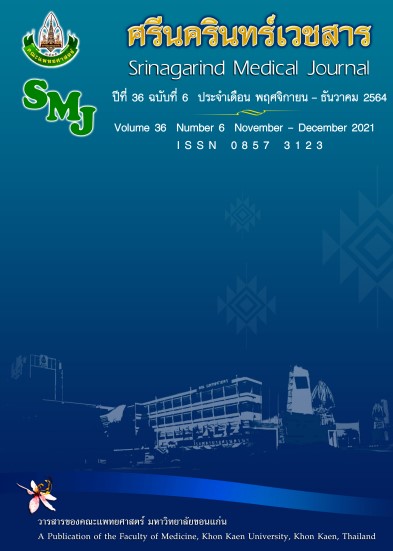ผลการอัลตราซาวด์กะโหลกศีรษะในผู้ป่วยแรกเกิดและทารกที่วินิจฉัยโรคเยื่อหุ้มสมองอักเสบเฉียบพลัน
คำสำคัญ:
Keywords: Cranial sonography; bacterial meningitis; neonates; infantsบทคัดย่อ
Abstract
Background and Objective: Bacterial meningitis is one of the most serious infections in neonates and infants with high morbidity and mortality. A combination of physical examination, cerebrospinal fluid (CSF) analysis, and imaging modality is essential for diagnosis. Cranial sonography (CRS) is an initial examination for intracranial evaluation in critically ill neonates and infants. This study aimed to evaluate the spectrum of cranial sonographic findings of acute bacterial meningitis in neonates and infants.
Materials and methods: Patients under 1 year of age with the diagnosis of acute bacterial meningitis who underwent CRS in Srinagarind Hospital between February 2009 and May 2018 were enrolled. Demographic data, CSF profiles, and CRS findings were retrospectively reviewed.
Results: The study comprised 39 acute bacterial meningitis cases with cranial sonography identified from 89 diagnosed cases. Most of which were less than 1 month (20/39, 51.3%). Group B Streptococcus (GBS) was the most common organism (5 out of 16, 31.3%), which was almost isolated in the first month of age (4 out of 5, 80.0%). Eighteen out of 39 cases (46.2%) showed normal CRS, whereas 21 cases (53.8%) showed abnormal CRS including echogenic sulci (18, 46.2%), ventriculomegaly (6, 15.4%), ventriculitis (8, 20.5%), accumulation of extra-axial fluid (12, 30.8%), parenchymal change (5, 12.8%) and venous sinus thrombosis (2, 5.1%).
Conclusion: Sonographic findings in acute bacterial meningitis revealed both normal and a large number of abnormalities which most frequent abnormality was echogenic sulci. Therefore, it is important to familiar with these findings in order to make a prompt diagnosis and provide appropriate treatment.
Keywords: Cranial sonography; bacterial meningitis; neonates; infants
บทคัดย่อ
หลักการและวัตถุประสงค์: โรคเยื่อหุ้มสมองอักเสบจากเชื้อแบคทีเรียในเด็กแรกเกิดและทารกเป็นการติดเชื้อที่รุนแรงและมีอัตราการเสียชีวิตสูง การวินิจฉัยอาศัยการตรวจร่างกาย ผลตรวจน้ำไขสันหลังและภาพวินิจฉัยประกอบกัน การตรวจอัลตราซาวด์กะโหลกศีรษะเป็นการตรวจแรกที่ใช้ในการประเมินรอยโรคในสมองในเด็กทารกโดยเฉพาะในหอผู้ป่วยวิกฤต ดังนั้นการศึกษานี้จึงมีวัตถุประสงค์เพื่อศึกษาลักษณะของภาพอัตราซาวด์กะโหลกศีรษะในผู้ป่วยแรกเกิดและทารกที่วินิจฉัยโรคเยื่อหุ้มสมองเฉียบพลัน
วิธีการศึกษา: ข้อมูลผู้ป่วย ผลการตรวจน้ำไขสันหลัง และผลการตรวจอัลตราซาวด์กะโหลกศีรษะ ของผู้ป่วยเด็กแรกเกิดและทารกที่อายุน้อยกว่า 1 ปี ที่ถูกวินิจฉัยโรคเยื่อหุ้มสมองอักเสบที่โรงพยาบาลศรีนครินทร์ ระหว่างเดือนกุมภาพันธ์ พ.ศ. 2552 ถึงเดือนพฤษภาคม พ.ศ. 2561 ได้รับการเก็บข้อมูลย้อนหลัง
ผลการศึกษา: ผู้ป่วยทั้งหมด 39 รายที่วินิจฉัยภาวะเยื่อหุ้มสมองอักเสบ พบว่าส่วนใหญ่อายุน้อยกว่า 1 เดือน (20/39, ร้อยละ 51.3) โดยเชื้อที่พบส่วนใหญ่ได้แก่ Group B Streptococcus (GBS) (5/16, ร้อยละ 31.3) ซึ่งร้อยละ 80 ของเชื้อพบในเด็กอายุน้อยกว่า 1 เดือน จากผู้ป่วยเยื่อหุ้มสมองอักเสบทั้งหมด 39 ราย พบว่า มีผู้ป่วย 18 ราย (ร้อยละ 46.2) มีผลอัลตราซาวด์กะโหลกศีรษะปกติ ในขณะที่ 21 ราย (ร้อยละ 53.8) พบลักษณะผิดปกติ ได้แก่ เยื่อหุ้มสมองหนามากกว่าปกติ (18, ร้อยละ 46.2) โพรงสมองโตขึ้น (6, ร้อยละ 15.4) โพรงสมองอักเสบ (8, ร้อยละ 20.5) มีน้ำในช่องนอกเนื้อสมอง (12, ร้อยละ 30.8) เนื้อสมองมีความผิดปกติ (5, ร้อยละ 12.8) และลิ่มเลือดในหลอดเลือดดำในสมอง (2, ร้อยละ 5.1)
สรุป: ลักษณะของภาวะเยื่อหุ้มสมองอักเสบในอัลตราซาวด์พบได้ทั้งไม่มีความผิดปกติ และมีความผิดปกติ โดยเยื่อหุ้มสมองหนามากกว่าปกติพบได้บ่อยที่สุด การที่แพทย์คุ้นเคยกับลักษณะเหล่านี้จะช่วยให้วินิจฉัยโรคได้รวดเร็วและให้การรักษาโรคได้เหมาะสม
คำสำคัญ: อัลตราซาวด์กะโหลกศีรษะ; ภาวะเยื่อหุ้มสมองอักเสบ; เด็กแรกเกิด; ทารก




